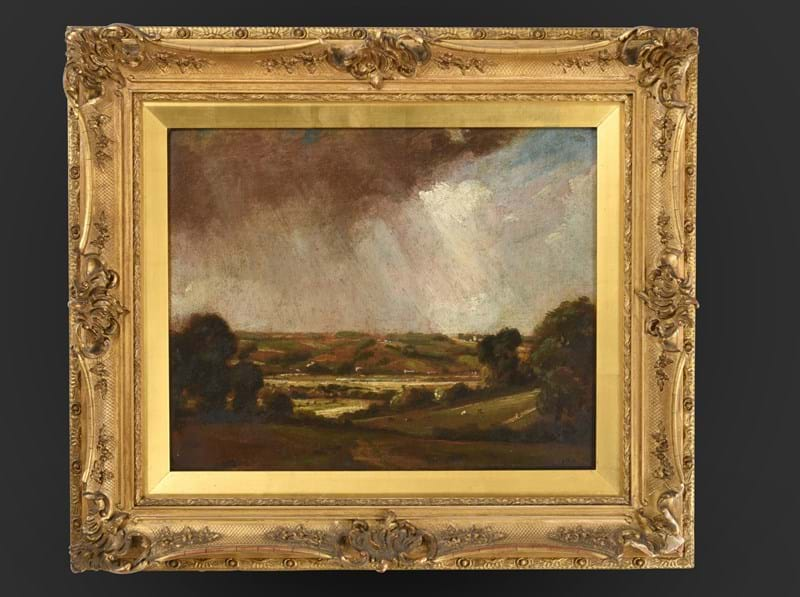ALFRED WALLIS
Alfred Wallis (1855-1942), retired mariner and self-taught artist, is much celebrated for his naïve paintings that reflect his direct experience of the sea and fishing communities in Cornwall. This October, “Houses, Trees and Ships”, which carries an impressive artistic provenance, will be offered for sale in Tennants Auctioneers’ Modern and Contemporary Art Sale with an estimate of £15,000-20,000 (plus buyer’s premium).
The painting was given by Dame Barbara Hepworth to fellow St. Ives artist Peter Lanyon and his wife Sheila for their wedding in 1946. Mrs Markova Noel, from whose estate it is now being sold, purchased “Houses, Trees and Ships” from Sheila Lanyon in the 1970s, before loaning it to Sheffield Museums Trust.
Alfred Wallis spent his childhood in Devon and Cornwall and worked as an apprentice basket maker before becoming a mariner in the merchant service in the early 1870s, sailing schooners between Penzance and Newfoundland. Following his marriage to Susan in 1876, when he was 20 and she was 41, he found work deep sea fishing off Newfoundland before switching to local fishing and labouring in Penzance. In 1890 the family moved to St. Ives, where Wallis became a dealer in marine reclamation and supplies.
When his wife died in 1922, Wallis took up painting ‘for company’, never seeking any form of artistic training. Using a limited palette of marine paint and any scraps of cardboard, packing box or wood he could get hold of, he developed his own unique style, depicting what he knew best – port landscapes and shipping. His instinctive, naïve approach saw formal perspective abandoned, and scale was often based on an object’s importance in a scene. Everything he drew came from his memories, largely from his formative years before sail gave way to steam. Indeed, he is recorded as saying he painted “What use To Bee out of my memory what we may never see again”.
The present painting is dominated by Wallis’s distinctive, idiosyncratic trees, which are perfectly described by Edwin Mullins in Alfred Wallis, Cornish Primitive Painter, Unicorn Press Ltd., 2014:
"Nothing in Wallis is more child-like than the trees he painted. In contrast to his ships, he never tried to describe his trees accurately – perhaps because there was no rigging for the old sailor in him to bother about. He just set his trees down on the ground like great black skittles sprouting hundreds of little stiff arms. What did impress him about trees was how their dark massiveness could belittle the houses and people beneath; also how a forest can become a secret and magic garden full of birds, animals and flowers."
Painting solely for his own enjoyment, he was discovered in 1928 by founding members of the St. Ives School, Ben Nicholson (first husband of Barbara Hepworth) and Christopher Wood. Wallis’s direct approach to image making had a profound impact on Nicholson and his work, and Nicholson later said of Wallis, "Using the materials nearest to hand is the motive and method of the first creative artist. Certainly, his vision is a remarkable thing with an intensity and depth of experience which makes it much more than merely child-like".
Harold Stanley ‘Jim’ Ede, an art collector, champion of Modern Art and friend of a great many avant-garde artists, was introduced to Wallis through Nicholson and Wood, and promoted his work in London. Whilst Wallis’s work became celebrated amongst a circle of progressive artists in the 1930s, he never saw commercial success in his lifetime, remained living in poverty, and would spend the last year of his life in the workhouse in Madron, whilst his work hung in London.
Wallis left and extraordinary artistic legacy, and the influence his work had on the direction of British art in the 20th century cannot be understated. Nicholson summed up Wallis’s work when he stated it was “Something that has grown out of the Cornish seas and earth, and which will endure”.
CHRISTOPHER WOOD
Being sold from the same estate are two works by Christopher Wood (1901-1903), who in his short life became held in high regard amongst artistic circles in both London and Paris, being remembered as a youthful genius. On offer are two works in pen and ink; “Footbridge on the Seine” from 1924, which comes with provenance from the Redfern Gallery, having been purchased there in 1945 by R. Gathorne-Hardy (estimate: £6,000-9,000) and “Two Nudes”, which was once in the collection of the artist’s sister, Elizabeth Dalziel Smith (estimate: £1,500-2,000), both of which were loaned to Sheffield Museums Trust by Mrs Markova Noel.
Christopher Wood was born near Liverpool and began drawing whilst recovering from septicaemia aged 14. After studying architecture and medicine for just a year at university, he moved to London in 1920. Here he met an art collector, wo invited him to Paris, where he studied drawing a the Académie Julien.
He was drawn effortlessly into fashionable artistic circles, where he met Augustus John and the diplomat Antonio de Gandarillas, whom he moved in with and was supported by. He also introduced him to the likes of Picasso, Jean Cocteau and George Auric, along with opium. Following the last-minute cancellation of a commission for designs for the Ballets Russe, Wood moved back to London, becoming first a member of the exhibiting collectives the London Group, and then the Seven and Five Society.
Formatively, he exhibited with Ben and Winifred Nicholson in 1927, with whom he would become close friends, especially Winifred, who supported him through a failed elopement with a Guinness heiress. Wood accompanied the Nicholsons on painting trips to Cumberland and Cornwall, and in St. Ives discovered Alfred Wallis, whose ‘primitive’ expressionism helped Wood develop his own style.
In 1929 he was given a solo show at Arthur Tooth & Sons, and a rather less successful joint exhibition with Ben Nicholson in Paris. Having had a painting expedition to Brittany, the resulting paintings were due to be exhibited at Wertheim Gallery in London. However, Wood was struck by a train whilst travelling back from meeting his mother, thought to be suicide brought on by psychosis, despite being reported as an accident at the time. Posthumously, his work was widely exhibited.
View Sale













